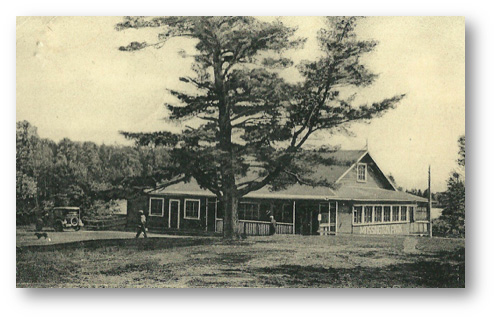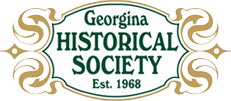Click to Download the PDF
Download the Word Doc
President’s Message
Welcome to the June edition of the Georgina Historical Society newsletter.
The Noble House was filled to capacity on Tuesday, May 21 to listen to our guest speaker.
Jake Charles, from Georgina Island gave a very interesting talk on native plants, their healing properties, traditional medicines and native culture and beliefs. A great discussion with lots of questions followed his talk. We all look forward to him returning in the future.
This Tuesday, June 18th . the General meeting will be held at. St George’s Anglican Church. Hope to see you all there. Andrew Sibbald will talk about the history of the church and give us a tour of the church, the grounds and the cemetery. Volunteers are needed to help in the village on July first. Please contact Melissa Matt if you can help.
On a sad note, Julia Munro from Belhaven, long time MPP for York Simcoe and a member of the Georgina Historical Society passed away on June 12th. Our condolences go out to her husband John Munro and all her family.
~ Tom Glover
The Strawberry Social – by Tom Glover
June is the month for strawberry suppers. In rural Ontario communities the Strawberry Social has long been used as a fund raiser for churches and community groups.
In 1900 the first strawberry social in the small community of Ravenshoe was held on the lawn of Mr. And Mrs. R, H. Weddell. The lawn was illuminated with torch lights and Chinese lanterns and the evening was a real success. A literary and musical program was presided over by Rev, Brown and the evening raised the grand sum of $55.00!
The event grew and by the time the 5th annual strawberry supper / dinner party was on my grandparents lawn not only did local church members provide entertainment, but the Mount Albert Brass Band was imported to play for the evening.
The evening continued to grow and in the following years guests were entertained by the Sutton String Band, the Queensville Orchestra and guest soloists from neighbouring communities. Attendees came from many neighbouring communities to enjoy the meal, the entertainment, and socializing.
The following comment from a gentlemen from ‘Drytown’ sums up the evening; “…an enjoyable time and those Ravenshoe ladies are tolerable good cooks.”
No wonder the Strawberry Social became an annual event. By 1910 the supper had been moved to the church grounds. The church shed, where the horses were stabled during services was cleaned out and the supper held there (certainly this would not pass today’s health standards and regulations).
In the 1920’s a basement was dug and the church finally had a permanent place for its suppers. I am sure other communities in Georgina have similar stories about their Strawberry Suppers, a tradition that exists in many other places throughout Ontario. Be sure to attend a Strawberry Social in your community this year.
An Early Snapshot of Georgina and North Gwillimbury
The following is an excerpt from Volume II of Canada Past, Present, and Future, pages 36 to 38, written by W. H. Smith and published by Thomas Maclear of Toronto in 1851. Mr. Smith also put together the Canadian Gazetteer of 1846. He paints an interesting picture of our Town of Georgina as it existed almost one hundred and seventy years ago
“To the north, and a little east of Scott, is the township of Georgina, which is bounded on the north by Lake Simcoe. This township contains a considerable portion of good land, and is well watered, but from its remote situation, it settles up but slowly. In eighteen hundred and forty-two, it contained five hundred and eighty six inhabitants, and in eighteen hundred and forty-five there were two grist and three sawmills. In eighteen hundred and fifty, the population had increased to nine hundred and forty-six, there were two grist and three saw mills as before; and thirteen thousand bushels of wheat, eight thousand bushels of oats, three thousand bushels of peas, nine thousand bushels of potatoes, nine thousand bushels of turnips, eight thousand pounds of maple sugar, two thousand pounds of wool, four thousand pounds of cheese, and four thousand pounds of butter were produced from the crop of eighteen hundred and forty-nine.
In the west of the township, near the Lake, is a village called Sutton, but better known as “Bouchier’s (Bourchier’s) Mills.” It is twenty-three miles from the Holland Landing, and contains a grist and saw mill, carding and fulling mill, tannery and Post Office; and a new cloth factory is erecting. Lake Simcoe, which, from the facilities it affords to the settlers of the surrounding country for the transit of stores and produce, is of considerable importance, is the largest of the small lakes in Canada. In any other country it would be considered a Lake of some magnitude, but here, compared to Ontario, Erie, Huron, and though, last not least, the noble Superior, it is a mere fish-pond; and not a bad fish-pond either, as trout, whitefish and maskelonge of fine quality are taken in it.
Lake Simcoe in length, from the extremity of Cook’s Bay to the Narrows is about twenty-eight miles, and in width about seventeen, in addition to which, Kempenfeldt Bay is about eight miles in length, which will give the entire width of the Lake at twenty-five miles. It is a beautiful lake, and the scenery about it is very picturesque, particularly about the Narrows and Lake Gougichin (Couchiching). Cook’s Bay at the southern extremity of the Lake, is about seven miles in length ‘; about two miles from its termination, a stream called Maskelonge Creek enters it on its eastern side, and from the Creek to the same point on the opposite side of the Bay, the borders and bed of the Bay are marshy; this marsh extends southwards along the course of the Holland River for some miles, forming an extensive nursery for ducks, frogs and mosquitoes. The average depth of Cook’s Bay is about five or six fathoms (a fathom = six feet or roughly 2 metres).
Immediately above the mouth of the Bay a large Island called Snake Island, also occasionally called Muskego Island, from an Indian named Joe Muskego, who claimed it; and some distance above it, is a smaller Island, called Bird Island. These Islands have been improperly named on many maps; Snake Island has been called Muskego Island, and Bird Island has been named Snake Island. Snake Island is situated about three quarters of a mile from the south-east shore of the Lake and Bird Island about the same distance from the south-west coast. Snake Island contains about three hundred acres, and Bird Island nearly a hundred. The soil of Snake Island is stony, and that of Bird Island gravelly; The timber on both is hardwood, there being very little pine on either. Snake Island is occupied by a party of Chippewa Indians, who formed one of the three bands settled at Coldwater and the Narrows. At the last report they numbered one hundred and nine, and occupied twelve dwelling houses. They had also, two barns and a school house, in which their children were instructed by a respectable teacher; they had also, a resident Missionary of the Methodist persuasion. They had at that time, about a hundred and fifty acres under cultivation, and were said to be improving in habits of industry and agricultural skill; and the Missionary spoke highly of their moral character. The soil of the Island, however, was said to be not well adapted to Indian modes of culture, being too stony. The timber on the Island contains a considerable proportion of maple, and a large quantity of sugar is usually made on it. At the present time there is no Missionary on the Island, but the Indians have still a schoolmaster.
Between Snake Island and the main shore, the water is shallow, there never being more than from five to six feet in the deepest part. Between Snake and Bird Islands, there is deep water. At a distance of two or two and a half miles north-east from Bird Island is a singular shoal; it is about three quarters of a mile in length, and twenty-five or thirty yards in width. It is composed of gravel, and about eighteen inches depth of water on it. It appears to increase very little in size. At, and about Roche’s Point, (where is the new settlement called Keswick), the water is generally deep. There was formerly a wharf at this point, but it was carried away by the ice, in eighteen hundred and thirty-nine, and has not since been re-built. From Roche’s Point to Jackson’s Point on the south shore is about twelve miles by water. The land is low, timbered principally with hardwood, with a considerable quantity of cedar. The water is sufficiently deep to allow of the steamboat approaching pretty close to the land. About two miles and a half farther east, is Sibbald’s Point, between which and the large Island called Graves or Georgina Island, there is shoal water, and the Bay to the south of the Island” is bordered by tamarack swamp. To the south and a little east of the Island a long point of land runs out into the lake; this is called De Clot’s (Duclos) Point, and between this Point and the Island, the passage, which is about a mile wide, has a depth of eighteen or twenty feet water. Georgina Island contains about a thousand acres of land, much of which is of good quality. There are two Indian families settled on the Island.
From De Clot’s (Duclos) Point up to Point Mara, the shore is low and the water shoal, but there is plenty of Water between the latter point and Cabise Island….”
News
Jackie Diasio proposed a visit to the Halton County Railway Museum. Unfortunately the trip could not go forward as we did not have enough people to warrant arranging the use of a bus. This is a museum dedicated to electric railways and has rolling stock and equipment, including some similar to those that ran on our Metropolitan line from Toronto to Sutton. Perhaps we might be able to arrange this excursion at some later time this fall. At the very least we could arrange a car pool to this museum to learn more about Ontario’s radial railway heritage.
We are calling for volunteers to help us with Harvest Fest and other events which your society participates. If you are interested, contact Jackie at (905) 476-1329 or diasiojackie@gmail.com so that she may get your information into our volunteer database.
One of our directors, Paul Brady is being interviewed about the history of Jackson’s Point on the program ‘Our Georgina’ Rogers cable 10. Rogers Cable has shown an interest in more programming of this kind. This a wonderful opportunity for us to connect with the residents of Georgina to share information about our local history.
Events
Next Board Meeting: Tuesday, July 2nd, Noble House @ 2:00 PM
General Meeting: June 18th, St. George’s Church, Park Road and Hedge Road. 7:00 PM Andrew Sibbald will lead a tour and discussion.
Canada Day: July 1st
July volunteer meeting: Contact Jackie Diasio (905) 476-1329 diasiojackie@gmail.com
Board Meeting: Tuesday, September 3rd @ 2:00 PM
Harvest Fest: September 14th; volunteers needed! Contact Jackie.
General Meeting: September 16th venue, time and topic to be announced
Old Fashioned Christmas: November 28th.
Please note, publication of the newsletter will take a break for the summer after the June issue. In September we will resume publication once again.
Where in Georgina?

In April we introduced our next mystery location which so far has remained unidentified.
What is it and where was it located?
